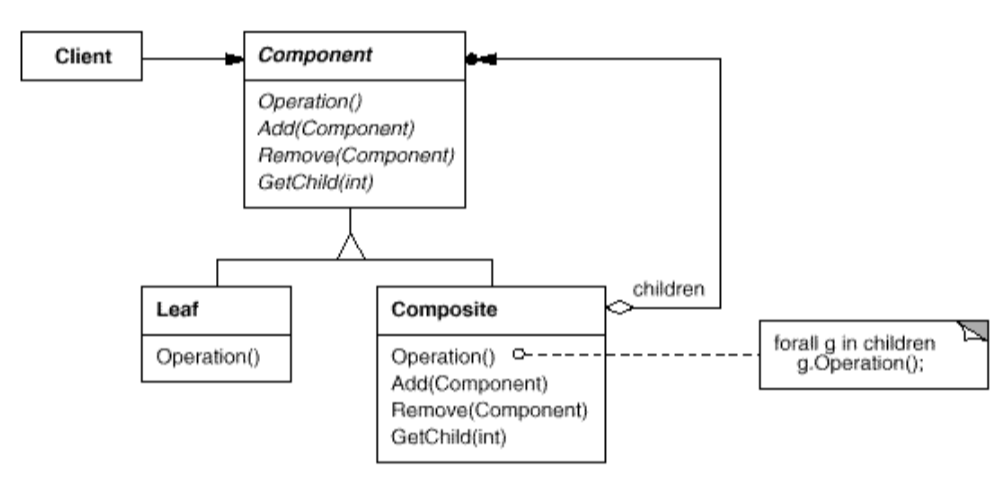Composite Pattern
Composition allows clients to treat individual objects and compositions of objects uniformly.
The Composite Pattern demonstrates how to use recursive composition to prevent clients from having to handle objects differently based on their primitive types or requiring different ways to contain those objects.
The key to the Composite Pattern is having an abstract class that represents all primitive objects and their containers. This abstract class also declares the operations that all composite objects will use. For example, in a GUI with different shapes, a function like draw() would be implemented uniformly for all shapes, such as Circle, Rectangle, or Triangle.
In this case, a class called Figure would be defined as an abstraction for all shapes. This Figure class would then be used as the element of any container in the system, but specifically as a pointer (or reference). Using pointers ensures that the abstraction retains information about the specific type of Figure at runtime. If regular objects were used instead of pointers, there could be a loss of data or information about the original shapes.

Clients use the Component class as an interface to interact with pointers within the Composite structure. If the recipient is a Leaf, the request is handled directly. Otherwise, the request is forwarded to its child components, potentially performing additional operations before and after returning the response to the client.
In this sense, the client cannot distinguish between a primitive object and a composite object, making the interface generic and adhering to the Liskov Substitution Principle (part of SOLID), which states that types should be interchangeable without affecting functionality. This simplifies client code, as there is no need for distinct logic for each type of class—everything can be managed by referencing a single class.
Additionally, new objects that comply with the Composite requirements can be added seamlessly. Since it is abstract, there are functions that must be implemented. For example, draw() must be called for every type within Figure, and there is no way to bypass this requirement.
In the implementation, it is essential to consider the following properties:
- Explicit Reference to parent(): Child classes must have explicit references to their parent in a recursive manner. This is typically achieved by providing a function that allows referencing a pointer to the parent. This simplifies the dependency flow from the Leaf classes at the bottom of the hierarchy to the higher levels, up to the Component. Usually, this parent() reference function is defined in the Component class. It is also important to note that the association with the parent should only occur during the creation and destruction of a specific child. Otherwise, complex inheritance references can break during runtime.
- Maximizing Class Interfaces: To ensure clients remain unaware of the specific types being used, it is recommended to define as many interfaces as possible in the abstract Composite class, which must then be implemented by its Leaf subclasses. However, care must be taken with this approach, as defining too many operations for the Leaf classes can sometimes become counterproductive.
- Deletion of Child Objects: Removing child objects should typically be handled by the Composite, as it owns its composition and is responsible for managing its children.
The Composite Pattern is commonly used in Model-View-Controller (MVC) architectures, where the View often encompasses both the Component and the Composite.
QObject
QObject is the base class for most Qt classes and implements the Composite Pattern, while also using signals and slots as part of the Observer Pattern. The Composite Pattern involves creating complex components through a tree-like hierarchy structure of simpler components, ensuring that clients cannot distinguish between complex and simple components.
There is a difference of what is a compose of different objects and what are the elements of a composition. The definitons are: Composite Object: An object that contains child objects. Component Object: An object that has a parent object.
QObject serves as both a composite and a component because it can reference another QObject as its parent. The highest level of composition in QObjects represents the root, while derived objects act as leaves. A QObject has a method called setParent(), which allows associating it with another QObject as its parent. Additionally, it provides recursive functions like findChildren(), which returns a QList of pointers to all its child objects. QObjects without parents are placed on the stack, whereas QObjects with parents are placed on the heap.
Container
Containers in the STL are C++ template classes designed to store objects or pointers. These containers are categorized into two main types: sequential containers and associative containers.
A relationship between containers and objects can be defined as a managed container when objects are used as the elements of the container. In this case, when the container is destroyed, all its elements are also destroyed. This type of relationship is known as composition. Alternatively, an associated container can be identified when, instead of storing objects directly, the container holds pointers to objects. In this scenario, when the container is destroyed, the objects themselves are not destroyed because the container only stores references (pointers) to those objects. This type of relationship is referred to as association.
Sequential Containers
Sequential containers can be classified as standard and non-standard, with standard containers being the most commonly used. Some notable examples include:
- Vector: A sequential memory container that is typically defined with an initial size. While it can be resized, this process is costly due to the need to reallocate memory and copy elements.
- String: Essentially a vector
with additional functionality specifically designed for handling character strings, such as concatenation, searching, and text manipulation. - Deque: A container similar to a vector but with the ability to efficiently expand at both ends, making it ideal for operations at the front and back of the sequence.
- List: A doubly linked list that does not store elements contiguously. It allows quick modifications, such as insertions and deletions at any position, but operations like sorting and iteration are more expensive compared to a vector due to its non-sequential memory structure
Associative Containers
Associative containers can be classified as standard and non-standard, with standard containers being the most commonly used. Some notable examples include:
- Map: A collection where the key and value can be different types. Keys must be unique.
- Set: A collection where the key and value are the same, effectively storing unique elements. Keys must also be unique.
- Multimap: Similar to a map, but allows multiple entries with the same key.
- Multiset: Similar to a set, but allows multiple elements with the same value (duplicate keys).
Qt Containers
Like some of C++’s non-standard containers, Qt also defines several containers that can be used, such as:
- QStringList: A class derived from QList
, specifically designed for handling lists of strings. - QHash: An associative container that uses a hash table to enable fast key lookups.
- QCache: An associative container optimized for quick access to recently used data while automatically removing items that are no longer frequently accessed.
Iterator
The Iterator Pattern provides a way to access the elements of an aggregate object sequentially without exposing its internal representation.
The core idea of this design pattern is to delegate the responsibility of accessing and traversing the elements of a list not to the list itself, but to an independent iterator object. The iterator defines an interface for accessing the elements of the list and is responsible for keeping track of the current element it is pointing to, as well as which elements have already been visited.
 [2]
[2]
A key rule is that an iterator should not exist without being assigned a list to traverse, as it may contain invalid data or null pointers, which would serve no purpose.
The idea of separating the iterator from its list is primarily to decouple the iteration functionality from the list’s interface. Additionally, it allows for** flexibility in creating different types of iterator**s with varying policies. For example, an iterator could be designed to traverse only elements that are read-only.
The purpose of applying the Iterator Pattern is to enable access to the contents of a container without exposing its internal representation. It also allows for defining uniform interfaces to traverse different types of associative containers, a concept referred to as polymorphic iteration.

Reference
[1] Ezust, A., & Ezust, P. (2006). An Introduction to Design Patterns in C++ with Qt 4. Prentice Hall. ISBN-10: 0131879057, ISBN-13: 978-0131879058.
[2] Gamma, E., Helm, R., Johnson, R., & Vlissides, J. (1994). Design patterns: Elements of reusable object-oriented software. Addison-Wesley.

